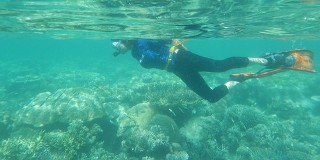Sep 14 2015
A tropical paradise on the surface, the coral reefs under the tiny island nation’s azure waves are actually a laboratory unlike anywhere else on the planet. The seemingly placid environment features some truly extreme conditions—an evolutionary crucible that has produced creatures with traits that rival the best of human ingenuity. Sweeney’s job is to understand how they got that way and why.
 Though Palau’s landscape is lush, surviving there is harder than it seems, and most plants can’t make use of the intense sunlight at the equator without being damaged.
Though Palau’s landscape is lush, surviving there is harder than it seems, and most plants can’t make use of the intense sunlight at the equator without being damaged.
Though Sweeney’s departmental colleagues include condensed-matter physicists and theoretical topologists, she is a biologist by training. She came to be in this interdisciplinary nexus because the biological structures she studies are exquisite manipulators of the electromagnetic spectrum. Many sea-creatures have evolved light-reflecting structures that are used to hide from predators, confuse prey, attract mates, and in the case of the giant clams that live in Palau, grow their own food.
The clams have a symbiotic relationship with algae, which grow in pillars inside their flesh. As the algae reproduce, they push each other off of the bottom of the pillars and into the clam’s stomach.
“They are essentially farming the algae for nutrients,” Sweeney says.
As part of the Evolution Cluster, which brings together scholars from across Penn Arts & Sciences’ departments to study different facets of this core scientific concept, Sweeney’s research involves understanding how the clams came to be able to perform this trick. Though Palau’s landscape is lush, surviving there is harder than it seems.
“Sunlight at the equator is so intense that most plants can’t make use of it without being damaged,” Sweeney says. “But we’ve found that the clams have a way of scattering the light into wavelengths that the algae can most efficiently absorb.”
The evolutionary solution that the giant clam has stumbled upon is a structure known as an iridocyte. Roughly spherical cells packed with reflective proteins, a layer of these iridocytes is spread on top of the pillars, giving the clams their iridescent sheen when seen from above. Below, the iridocytes spread that blue and red light to the sides of the algae pillars. Because the plants are green-brown, and thus reflect more light of those wavelengths, the clams can grow them most efficiently by sparing them from all but the most valuable photons.
Evolution has so precisely tailored giant clams to their environment that their algae-farming efficiency outstrips anything humans have achieved in the quest to use the single-celled plants as a biofuel. State-of-the-art bioreactors can quickly fill tubes or pools with the neon green organisms, but that is only half the battle. Algae on the surface of these reactors block light from reaching their brethren on the inside; to keep them all alive, the reactors must be constantly stirred, losing whatever energy gains harvesting the algae would produce.
With this challenge in mind, Sweeney is collaborating with the School of Engineering and Applied Science’s Shu Yang on a National Science Foundation grant that aims to replicate the light-scattering abilities of iridocytes with lab-made materials.
As part of that grant, they have drawn on another resource unique to Palau: its students. The funding will support a Palauan graduate student, who will travel to Penn to work with Sweeney and Yang, as well as several local interns.
“You’d be hard-pressed to find two more different places on the planet than Philadelphia and Palau,” Sweeney says, “ but students in both places face similar challenges in being very talented but lacking access to scientific infrastructure. Palau also has some of the last best coral reefs on earth. If we want to preserve coral reefs for the next generation, we need to invest in that infrastructure and in the students there.”